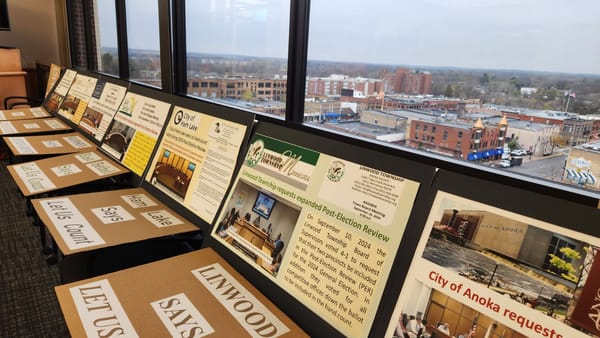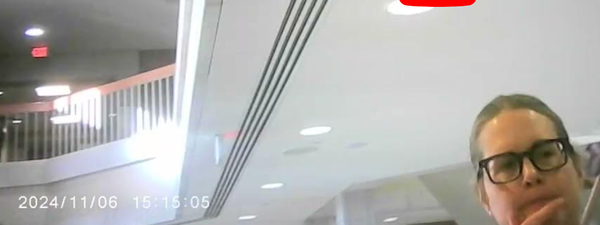Yes, there are alternatives to state- and corporate-controlled elections
Hand Count PROOF OF CONCEPT revealed by Clint Curtis and Mark Cook
I’ve met Mark Cook twice, once at the Cyber Symposium in 2021 and again at The Moment of Truth Summit in 2022. You might recognize him from his remarks during the Nye County Commissioner meeting on March 15, 2022—Nye County voted to hand count during that meeting and went on to hand count its November 8, 2022 midterm election and found hand counting to be more accurate than electronic tabulation, according to its election clerk.
A Fully Decentralized System
Mark Cook has more recently presented (see the 2hr23min-mark in the day 2 recording - 1.5 hour presentation, highly recommended) the election ecosystem in 4 components:
Voter Registration - controls # of ballots in circulation
mail ballots - creates an inventory of ballots with real-time tracking by select people/orgs
early voting - feed data analytics to monitor then inject votes undetected
Voter Validation - controls which ballots get counted
electronic poll books - provides real-time tracking by select people/orgs
signature validation - allows ballots into the system with inadequat verification
Tabulation - controls how ballots get counted
LAT/RLA - logic & accuracy tests and risk-limiting audits (post-election reviews in MN) provide false sense of accuracy/security to election officals and public
Reporting - controls what totals we see
unofficial/official results - provides times to cure any manipulation

This presentation clarified much for me. I love that Mark refuses to take anyone else’s word on the details and insists on looking for himself.
About halfway into the presentation, when he demonstrates how to electronically flip votes within a forensic copy of one of Colorado’s election management servers, it shocks some people in the room. It did when I saw this too.
The only way to have a decentralized government is a fully decentralized election system.
– Mark Cook
Minnesota’s Appetite for Transparency
In recent travels around Minnesota I’ve yet to see this kind of thinking take hold in enough elected officials and election staff.
But there really is an end in sight to the current mess. If you watch the presentation above (1.5 hours of your time—break it into chunks if you have to), then you will be more equipped than most people. It’s very important to understand the problems with the state- and corporate-controlled system as it exists today.
Then alternatives can be explored—scroll to end of this post to see a huge bright spot coming soon!
In the past month I’ve visited Anoka County to hear speeches given to their commissioners (library here), went to Edina in Hennepin County to observe vote tabulation (and asked for errors to be corrected) at the Senate District 50 Republican convention elections, and drove to Wright County to listen to the election staff give a presentation on their absentee voting process.
In Wright County on Monday, Elections Manager Tyler spoke about identical CVR requests pouring in across the country. Here’s an example of one for Dominion, and for ES&S, and for Hart systems, each in use in Minnesota (these data requests were modified from Jeffrey O’Donnell’s models—Jeffrey O’Donnell runs ordros.com alongside Draza Smith, who have collected in a repository about 1,000 CVRs nationwide). If you want to see the nearly identical denial responses to these requests, search ‘CVR’ on https://erikvanmechelen.substack.com.
Notice in the data request forms that we are not asking for a CVR, but rather “a text, comma, or tab delimited file”, which Tyler seemed to refer to as the ‘CVR spreadsheet’ and which one of the commissioners seemed amenable to sharing with the public. That would be nice given that we are coming up on three years since the 2020 election and it is illegal for the county to withhold public election data which has no personal identifying information and which no section of Chapter 13 in Minnesota’s statutes prevents. See Dodge County, WI government page for a model examlpe of sharing ballot images and CVR reports publicly.
But even releasing the CVR represents only a tiny amount of transparency, perhaps a transparency which the EAC envisioned when including this automatic feature of tabulators (of both capturing ballot images of front and back of ballots but also the interpretive file asked for in the public data request forms above) as a standard in its 2005 Voluntary Voting System Guidelines. The National Institute of Science and Technology (NIST) also includes a standard for cast vote records in its Special Publication 1500-103, Cast Vote Records Common Data Format Specification Version 1.
These standards are critical because they provide for auditability of tabulator functionality that is carried out by the tabulator itself in addition to the audit that could be done on the paper ballots themselves.
A Viable Alternative
It’s very apparent that many of the people I’ve met on balance know more than their elected officials and election staff about the election process and components, simply by virtue of studying and researching all the components and asking questions throughout the last two years.
Meanwhile elected officials responsible for elections (or election data) are discouraged from asking questions or being self-reflective. Instead they are encouraged to enter into restrictive contracts with various election vendors which further centralize the process and remove transparency, essentially handcuffing these representatives from helping people like you and me.
There’s a big caveat here which is that elected officials and election staff who do believe in transparency tend not to be as vocal as a commissioner like Couy Griffin in New Mexico who was part of a vote to remove Dominion equipment from his county (before being removed from his post). But those election officials know who they are throughout Minnesota and I believe they are quietely working to help and are actively listening.
Perhaps they are simply waiting for a viable alternative to state- and corporate-controlled election components to arrive which can be readily adopted in a coordinated approach.
Hand Count Proof of Concept
Throughout the state I’ve repeatedly heard the issue of time and money be brought up when discussions about alternatives arise.
Take a look at this video and I think you’ll be impressed by both the speed and very low price of implementation.
Innovation like this will mean that places like Nye County or Mat-Su Burough in Alaska which have opted for hand counting are not outliers, but leaders in a nationwide move toward precinct- and county-controlled 1) voter registration, 2) voter validation, 3) tabulation, and 4) reporting.
Video: PROOF OF CONCEPT: A single race on 100 ballots tabulated in 2m32s with full transparency (by Clint Curtis and Mark Cook)
All in 2 minutes, 32 seconds with under $400 invested. Full-scale precinct demo of a mock-election coming soon!




